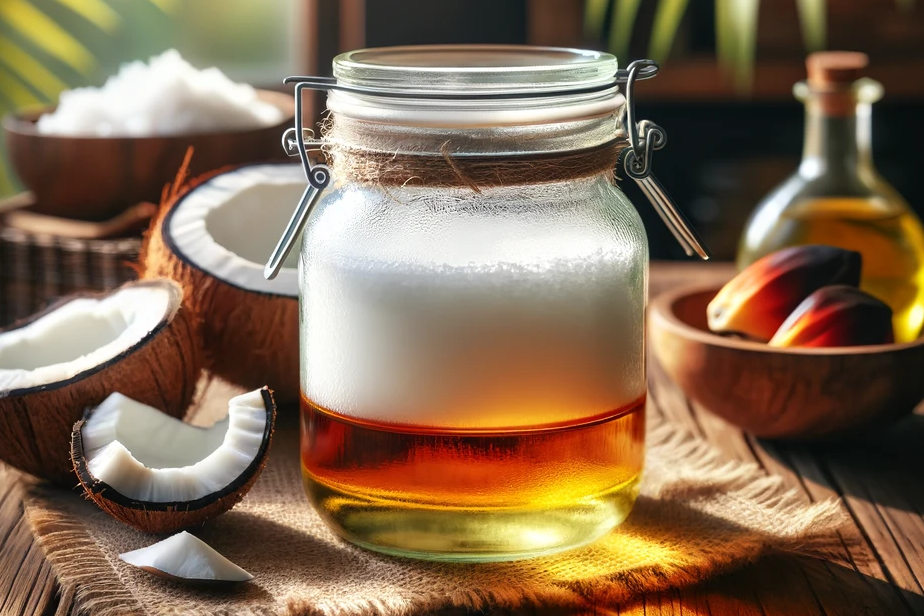Capric acid

Capric acid, also known as decanoic acid, is a saturated fatty acid consisting of 10 carbon atoms. It belongs to the medium-chain fatty acids (MCTs), which are metabolized more quickly than long-chain fatty acids. Capric acid is found in nature mainly in coconut oil, but also in other vegetable and animal oils.
The benefits of capric acid for dogs
Capric acid has several positive effects on the health and well-being of dogs. Here are some of them:
- Capric acid promotes energy supply to the brain. As capric acid is preferentially oxidized in the liver, more ketone bodies are produced, which provide an alternative energy source for the brain alongside glucose. This can be particularly beneficial for older dogs or dogs with epilepsy, as it can improve their cognitive abilities and seizure control.
- Capric acid supports the immune system. Capric acid has an antimicrobial effect, which means that it can act against various viruses, bacteria and fungi that can cause infections. For example, capric acid can inhibit the growth of Candida albicans, a fungus that can cause skin and ear infections in dogs.
- Capric acid regulates cholesterol levels. Capric acid can promote good HDL cholesterol in the body and reduce bad LDL cholesterol. This can reduce the risk of cardiovascular disease in dogs.
The disadvantages of capric acid for dogs
Capric acid also has some potential disadvantages or side effects for dogs that you should be aware of. Here are some of them:
- Capric acid can cause diarrhea. Because capric acid is digested quickly, it can cause increased intestinal peristalsis in some dogs, which can lead to soft or watery feces. This can happen especially if too much capric acid is given at once or if the dog has a sensitive digestion.
- Capric acid can lead to weight gain. Capric acid is a very energy-rich fatty acid that provides 9 kilocalories per gram. Giving too much capric acid or not balancing it with the total amount of food can lead to excessive calorie intake, which can lead to overweight or obesity in dogs.
- Capric acid can trigger allergies. While capric acid is rarely an allergen for dogs, some dogs may be allergic to coconut oil or other sources of capric acid. This can manifest as skin rashes, itching, swelling or breathing difficulties.
How do you give capric acid to dogs?
The easiest way to give capric acid to dogs is via coconut oil or special MCT oils, which have a high capric acid content. You should always pay attention to the quality and purity of the oil and only use native or cold-pressed oils.
The dosage of capric acid depends on body weight, health status and the aim of feeding. A general recommendation is to start with a small amount and slowly increase it until the desired effect is achieved. A possible guideline is :
| Body weight in kg | MCT oil in ml per day |
|---|---|
| 2,5 | 1-2,5 |
| 5 | 2,5-4 |
| 10 | 4-7 |
| 20 | 7-11 |
| 30 | 11-15 |
| 40 | 15-18 |
| 50 | 18-22 |
| 60 | 22-25 |
The oil should always be mixed with the food and not given on its own to improve tolerance. You should also always make sure that the dog has enough water available.
Capric acid is a medium-chain fatty acid found in coconut oil or special MCT oils. It has several benefits for the health and well-being of dogs, such as boosting energy supply to the brain, supporting the immune system and regulating cholesterol levels. However, it also has some possible disadvantages or side effects, such as diarrhea, weight gain or allergies. You should therefore always adjust the dosage, check the quality of the oil and observe the dog's reaction.
If you notice any signs of hypersensitivity or poisoning in your dog, you should see your vet immediately. We are not a substitute for a vet, but we try to be as accurate as possible. Every dog reacts differently and we recommend you get a second opinion or consult your vet if in doubt.
Stay healthy and take good care of your four-legged friend!😊
Similar to Capric acid
Caprylic acid is a saturated fatty acid with eight carbon atoms in its structure. It belongs to the so-called medium-chain triglycerides (MCTs), which differ from the long-chain triglycerides (LCTs)...
Caproic acid occurs chemically bound in milk fat triglycerides in milk and also in coconut oil. It is also found esterified in various seed oils and essential oils; spruce needle oil, lavender oil,...
Lauric acid is a medium-chain fatty acid (MCFA) found mainly in coconut oil and to a lesser extent in palm kernel oil and the milk of some mammals. This particular fatty acid has attracted the...
Palmitic acid is an organic acid with the chemical formula C16H32O2. It is a saturated fatty acid, i.e. it has no double bonds between the carbon atoms. Palmitic acid is a colorless solid at room...



